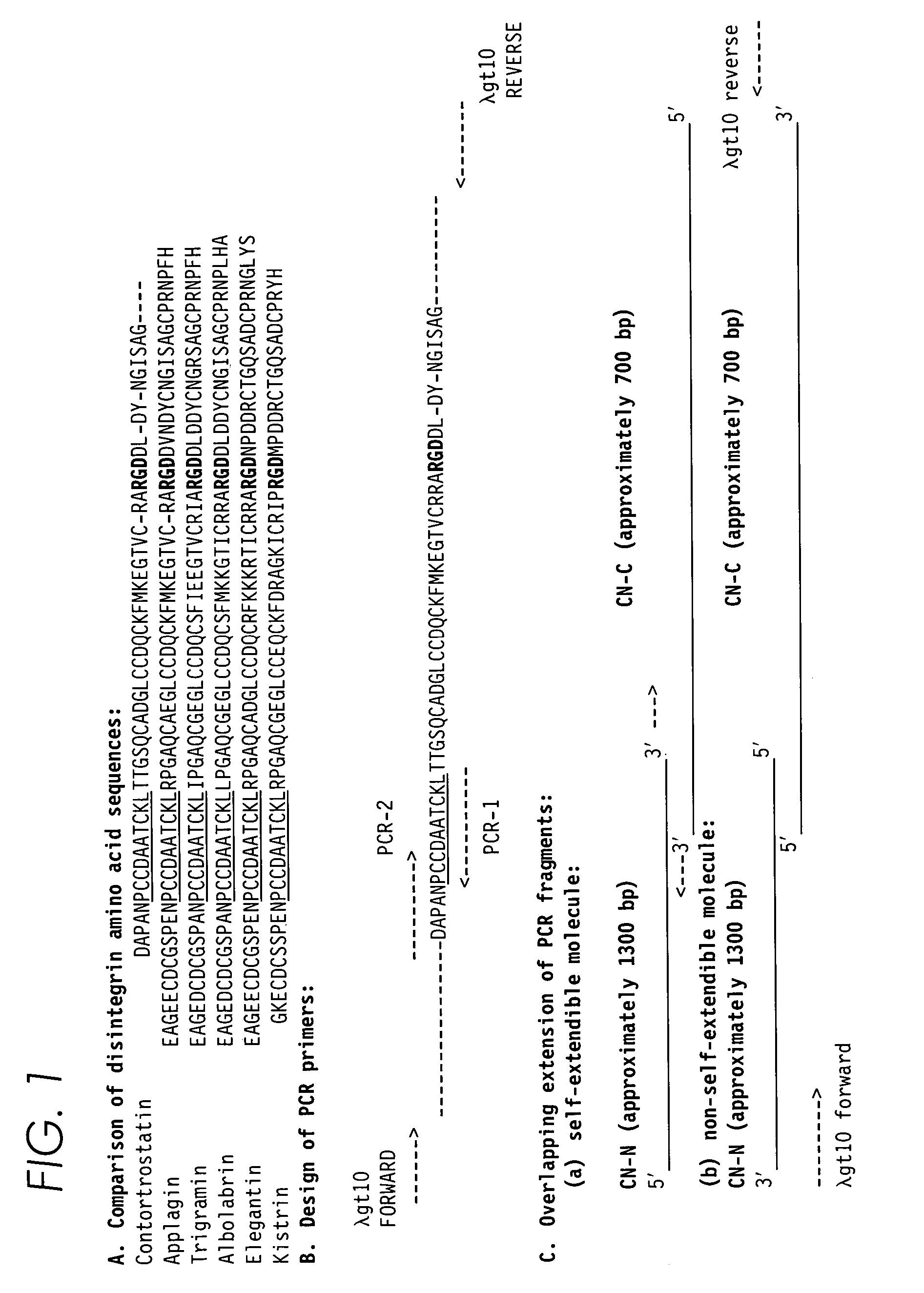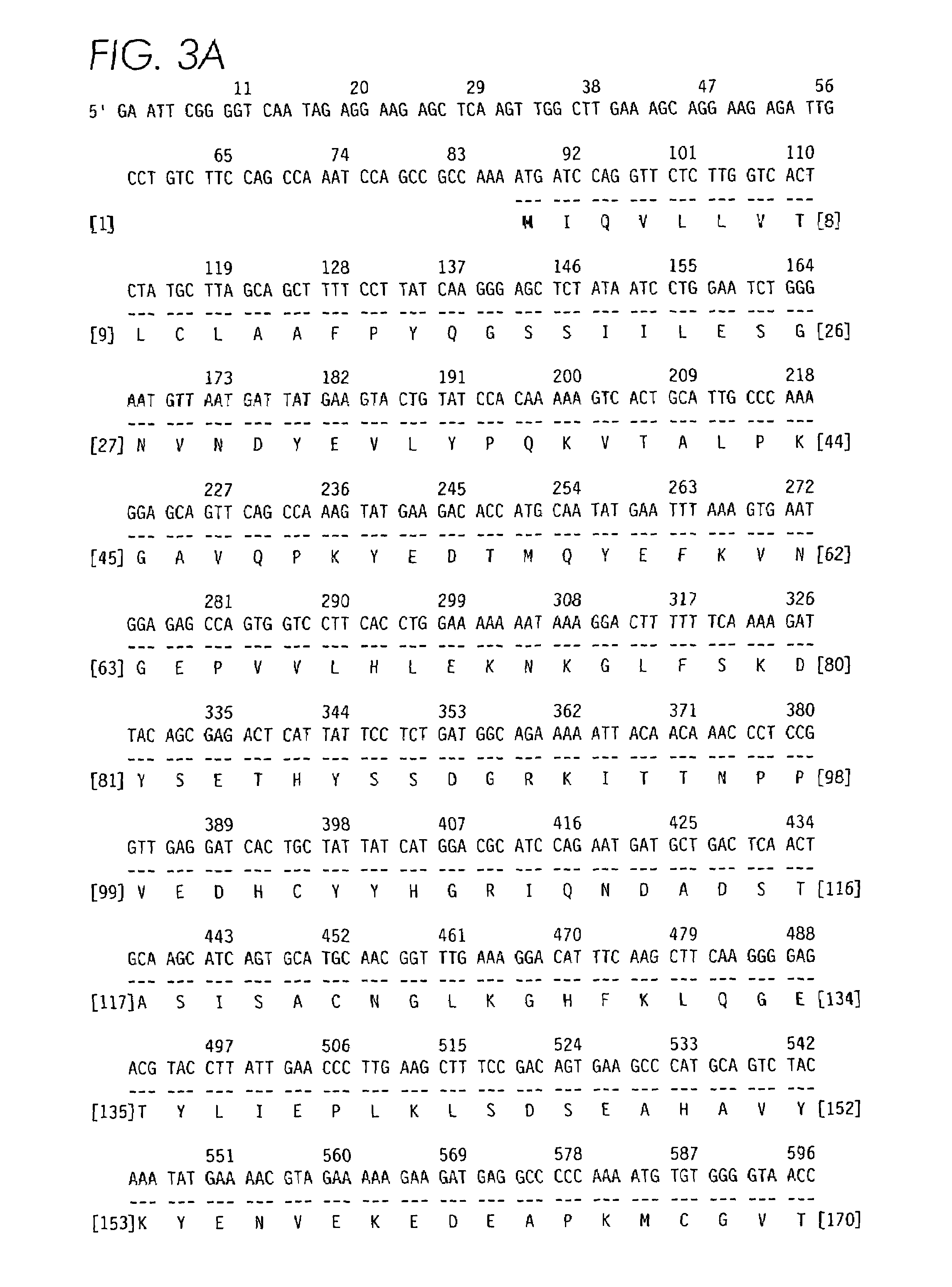Contortrostatin CN and methods for its use in preventing metastasis and other conditions
a technology of tumor cell and cn, which is applied in the direction of peptide/protein ingredients, drug compositions, peptide sources, etc., to achieve the effect of inhibiting cell adhesion, inhibiting the binding of human mammary carcinoma cells, and inhibiting tumor cell motility
- Summary
- Abstract
- Description
- Claims
- Application Information
AI Technical Summary
Benefits of technology
Problems solved by technology
Method used
Image
Examples
example 1
Purification and Characterization of CN
[0093]CN was purified from Agkistrodon contortrix contortrix (Southern copperhead) venom using a four step HPLC procedure. For the first step of purification crude venom (1 g) was dissolved in 0.1 M phosphate buffer containing 1 M ammonium sulphate, pH 6.8 (buffer A) and applied to the polypropyl aspartamide HIC-HPLC column. Elution was achieved as follows: 50 minutes isocratically with 100% buffer A; a linear gradient for 90 minutes to 0.1 M phosphate, pH 6.8 (buffer B); 40 minutes isocratic at 100% buffer B. Fractions of 10 ml were collected in a Pharmacia Frac 100 fraction collector at 4° C. using a flow rate of 5 ml / min. Fractions containing platelet aggregation inhibiting activity were pooled and concentrated by ultra-filtration using an Amicon stir cell with a YM3 membrane. Proteins were detected at 280 nm; platelet aggregation inhibiting activity was observed in the flow through.
[0094]Further purification was achieved by C18 RP-HPLC. Fra...
example 2
cDNA Cloning of Contortrostatin Using Polymerase Chain Reaction
[0100]Partial amino acid sequence analysis of contortrostatin using Edman degradation methods suggested that the subunit of contortrostatin is homologous with other disintegrins (FIG. 1A) with the cysteine residues aligned, as well as the RGD sequences [Niewiarowski, S. et al., Seminars in Hematology 31: 289–300 (1994)]. The strategy for cloning contortrostatin cDNA with PCR is based on the structural homology among the disintegrin family. Design of the PCR primers is schematically illustrated in FIG. 1. The underlined sequences in FIG. 1A are highly conserved among disintegrin family. PCR primers were synthesized based on this region. The nucleotide sequence coding this region in the cDNA of trigramin from Trimeresurus gramineus was used to synthesize the primers PCR-1 and PCR-2 (FIG. 1B). PCR-1 and PCR-2 are complimentary primers corresponding to the coding sequence of a consensus sequence PCCDAATCKL (e.g., amino acids...
example 3
PCR Amplification of Contortrostatin cDNA
[0103]We used the cDNA library of Agkistrodon contortrix contortrix venom gland constructed in λgt 10 vector at the EcoRI site. The estimated titer of the library was 1010 plaque-forming units (pfu) / ml and the complexity was 50,000. 500 μl of the cDNA library phage solution was mixed with 500 μl of 20% polyethylene glycol (PEG) / 1M NaCl solution in an Eppendorf tube. The Eppendorf tube was inverted twice and incubated at room temperature for 30 min. The solution was then centrifuged at 14,000 rpm for 10 min. The supernatant was discarded and the pellet was resuspended in 100 μl of sterile water. The suspension was incubated with 10 μl of proteinase K (10 mg / ml) at 50° C. for 1 hr. The phage particle suspension was extracted with phenol / chloroform twice and the DNA was precipitated with 1 / 10 volume of 3M sodium acetate and 2 volumes of absolute ethanol followed by washing with 80% ethanol. DNA was resuspended in 10 μl of sterile water in prepar...
PUM
| Property | Measurement | Unit |
|---|---|---|
| molecular weight | aaaaa | aaaaa |
| molecular weight | aaaaa | aaaaa |
| dissociation constant | aaaaa | aaaaa |
Abstract
Description
Claims
Application Information
 Login to View More
Login to View More - R&D
- Intellectual Property
- Life Sciences
- Materials
- Tech Scout
- Unparalleled Data Quality
- Higher Quality Content
- 60% Fewer Hallucinations
Browse by: Latest US Patents, China's latest patents, Technical Efficacy Thesaurus, Application Domain, Technology Topic, Popular Technical Reports.
© 2025 PatSnap. All rights reserved.Legal|Privacy policy|Modern Slavery Act Transparency Statement|Sitemap|About US| Contact US: help@patsnap.com



